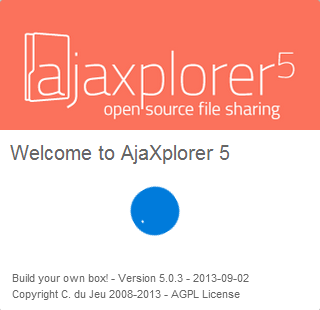Update 2015-08-15: This article is now outdated. The Pydio website now contains accurate Pydio 6 configuration at https://pyd.io/nginx/.
AjaXplorer (now rebranded Pydio) is a nifty web file sharing platform that can be used as a personal cloud.
It offers a Desktop Client now in beta but it seems promising.
Install required packages
Add the package repositories to /etc/apt/sources.list
deb http://dl.ajaxplorer.info/repos/apt stable main deb-src http://dl.ajaxplorer.info/repos/apt stable main
Then in the command shell:
wget -O - http://dl.ajaxplorer.info/repos/[email protected] | apt-key add - apt-get update apt-get install ajaxplorer mysql-server apache2 php5 php5-mysql
Create a database
In a MySQL shell started with mysql -p
CREATE DATABASE ajaxplorerdb; GRANT ALL PRIVILEGES ON ajaxplorerdb.* TO "ajaxplorerdb"@"localhost" IDENTIFIED BY "longandrandompassword"; FLUSH PRIVILEGES; EXIT;
Create SSL certificates
openssl req -x509 -nodes -days 365 -newkey rsa:2048 -out /etc/ssl/localcerts/ajaxplorer.pem -keyout /etc/ssl/localcerts/ajaxplorer.key
Adjust the PHP configuration
AjaXplorer recommends to disable the output buffering of PHP for improved performances.
In /etc/php5/apache2/php.ini find this line:
output_buffering = 4096
And replace it by:
output_buffering = Off
Note that in the default configuration, this line appears twice, once commented, once not commented!
Create Apache configuration files
Create the VirtualHost for ajaxplorer:
/etc/apache2/sites-available/ajaxplorer.vhost
<VirtualHost *:443> ServerAdmin [email protected] ServerName ajaxplorer.domain.com SSLEngine on SSLCertificateFile /etc/ssl/localcerts/ajaxplorer.pem SSLCertificateKeyFile /etc/ssl/localcerts/ajaxplorer.key DocumentRoot /usr/share/ajaxplorer <Directory "/usr/share/ajaxplorer"> Options FollowSymLinks AllowOverride Limit FileInfo Order allow,deny Allow from all </Directory> ErrorLog ${APACHE_LOG_DIR}/ajaxplorer_error.log # Possible values include: debug, info, notice, warn, error, crit, # alert, emerg. LogLevel warn CustomLog ${APACHE_LOG_DIR}/ajaxplorer_access.log combined </VirtualHost>
Create a redirection from unsecured to secured connection:
/etc/apache2/sites-available/ajaxplorer-redirect.vhost
<virtualhost *:80>
ServerName ajaxplorer.domain.com
KeepAlive Off
RewriteEngine On
#RewriteCond %{HTTP_HOST} ^[^\./]+\.[^\./]+$
RewriteRule ^/(.*)$ https://%{HTTP_HOST}/$1 [R=301,L]
</virtualhost>
Activate Apache configuration
a2enmod rewrite a2enmod ssl a2ensite ajaxplorer.vhost a2ensite ajaxplorer-redirect.vhost service apache2 restart
Browse your server and follow the installation steps.
Note that the default locations for file storage is in /var/lib/ajaxplorer/data/

Good tutorial !
So, you can create only one single v.host. And remove the 000-default site, or don’t work the redirect.
Yes, good point, if you keep the 000-default the redirect won’t work, you can delelte it with
rm /etc/apache/sites-enabled/000-defaultI will update the article.
For the single v.host, yes, if you prefer you can create only only. I took the habit of creating one file per VirtualHost instruction for clarity working with other people.
Cheers